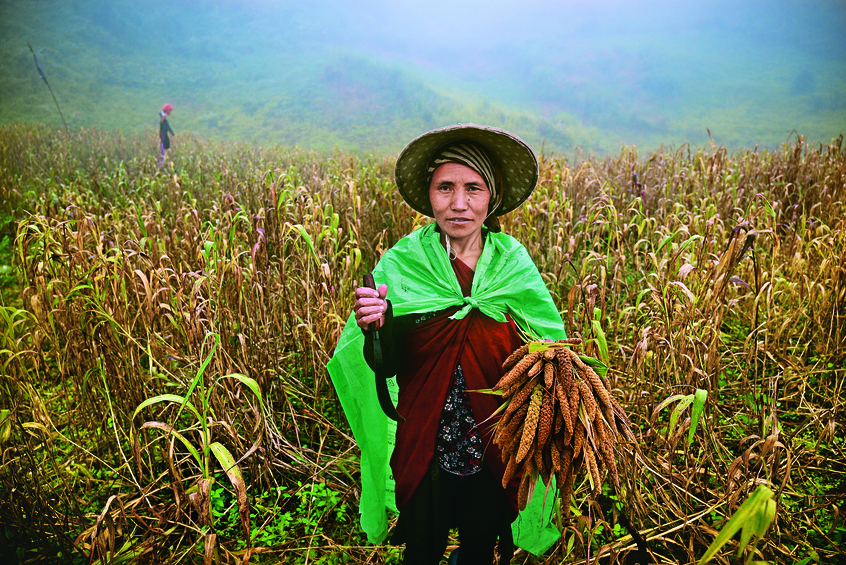
PLANTING HOPE IN THE VOICELESS
Years of exemplary efforts by the National Bank for Agriculture and Rural Development (NABARD) have ignited hope in many dark corners across the country
From distress to progress, NABARD has been instrumental in transforming lives nationwide. Collaborating with self-help groups, rural experts, and passionate change-makers, the bank has brought hope to disadvantaged communities, including voiceless tribal groups. Through initiatives in farming, education, livelihood, and gender empowerment, NABARD has catalysed positive change, empowering individuals to realize their dreams. Stories of transformation, such as blooming orchards in Dahod, fragrant Mushqbudji rice in Kashmir, and flourishing fox millet farms in Nagaland, are testament to the resilience of the human spirit
With the help and unstinted guidance of NABARD, doughty farmers in the harsh hills of Nagaland rediscover the art of cultivating foxtail millets and reap rich rewards from selling their harvest to increasingly fitness-conscious urban markets looking to replace rice and wheat with healthy alternatives.
Lashed by heavy downpours on a windy mountaintop, a group of women work unruffled at a farm on a late-September day in the high-altitude village of Zhavame in the Phek district of Nagaland. These farmers, wearing gum boots and woollen caps, are harvesting foxtail millet with just a plastic sheet to shield them against the drenching rain. This is their first crop of millet in decades.
As the rain ceases, small birds flock to the fields to feed on the millet, prompting the women to bang at metal plates to chase them away, one at a time. “The birds are a problem. When we are not working in the field, we take turns to guard the crop, “says Mary.
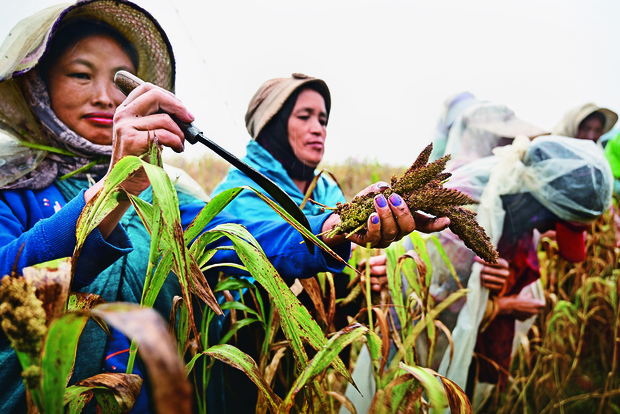
Nagaland’s millet revival: Farmers harvest the ancient grain, against the odds of weather and wildlife
“ In the village of Zelome, around 40 members have started growing foxtail millet, even though the project only supported 25 SHG members.
Mary is part of one of the 225-member self-help groups (SHG) in the Zhavame village supported by NABARD to cultivate foxtail millet.
Millet, once a Phek district staple rich in nutrients, was edged out by paddy as preferences shifted, nearly vanishing except for a few small-scale cultivators. The Chakhesang tribe villages, now experiencing a millet resurgence and situated 11 to 15 km from Pfutsero—known for organic cabbage, potato, and apples—faced challenges in earning fair prices due to inadequate storage and market access. This revival of millet cultivation offers them a beacon of hope.
Mary from Zhavame says, “Our forefathers used to do it ages ago. We have forgotten those practices. Last year, NABARD offered to support us in cultivating millet alongside other crops. The local Krishi Vigyan Kendras (KVKs) trained us on sowing and cultivation.” Then, NABARD initiated a project to promote the indigenous germplasm of Foxtail Millet and preserve the genetic diversity of this crop in Phek through seed banks. The project spans two phases, from July 2022 to July 2024.
In the first year (2022-23), four hectares of Zhavame and Zelome were covered. The selected beneficiaries are being trained to cultivate foxtail millets by the KVK in Phek, which has partnered with NABARD for the project.
Dr Imsunaro, District Development Manager, NABARD, explains that millet was once a staple food alongside rice in this area. However, unlike other places where millet is used to make cakes, milk, and snacks, the locals only had a few recipes. Additionally, threshing and preparing the millet harvest
was more arduous and time-consuming than rice. As a result, the cultivation of foxtail millet declined.
The farmers who had stopped cultivating millet are now being educated on the market demands and possibilities of value addition, spurring its revival. As the production increases in the coming years, more SHG members and other villagers will be trained to cultivate the crop. Harvesting started in September in Zhavame, while Zelome had already sown the second millet crop.
Hannah Krujia Asangla, Chief Technical Officer from ICAR-KVK Phek, who supervises the scientific management of millet cultivation, explains, “Zelome is located downhill and has a warmer temperature. Their crop was ready for harvest in July, yielding 1400 kg per ha from 10 kg seed per ha. Sowing was done concurrently with the harvesting, meaning the new crop will be ready to reap by December.”
In the village of Zelome, around 40 members have started growing foxtail millet, even though the project only supported 25 SHG members. Zelome is a small community of 218 households, and most people here rely on agriculture for their livelihoods. Last year, when NABARD and a KVK approached the village to reintroduce millet cultivation, many farmers were enthused by the idea. Some even started growing millet without any support.
The project has sparked a community-wide movement. Sasu Krome, Zelome’s Village Council Chairman, shares, “We are a close-knit community and very happy with the success of this project. We’re eager to learn more about value additions.” Similarly, Vizovonuo Domeh from Zhavame adds, “Although it is our first attempt at cultivating millet, we are happy with the output. The market demand for this crop is high and will help me earn more for my family. We want to do it again.”
Rakongnolu Zholia, the Church leader in Zelome, shared their selective approach to cultivating foxtail millet, focusing on taste, “We had originally cultivated several varieties of foxtail millet; however, we had limited it to just four now. Not all varieties are tasty, and we have chosen to grow only the tastier ones.”
In Phek district, there are ten varieties of foxtail millet, categorized into sticky and non-sticky. The preferred sticky varieties, known for their superior taste and higher demand, include ketha suthu, muzhame suthu, chisu sihia, and vorebu, while the non-sticky types are chisu, ngopirhu, zhobusu, and murasu.
Supporting these efforts, NABARD funded a seed bank in Zelome to preserve the germplasm of foxtail millet alongside other indigenous plants. This project aims to educate farmers on scientific management to enhance millet
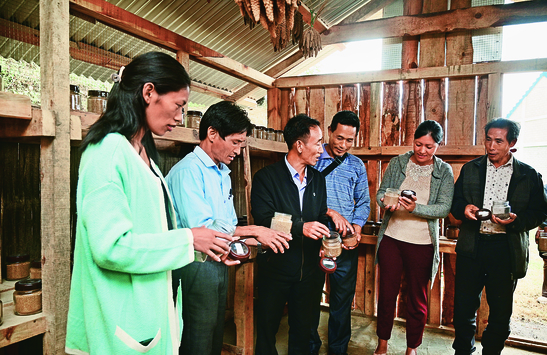
Zelome’s community leaders assess millet varieties, ensuring the future of their culinary heritage
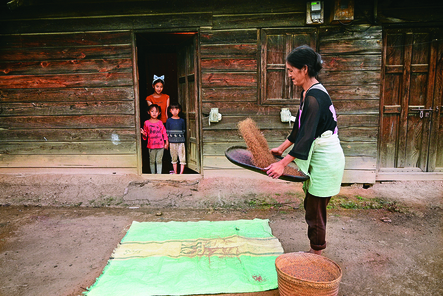
A Zhavame villager processes millet, revitalising a nutrient-rich staple of their ancestors
production, improve crop quality, and boost marketability, thereby improving farmers’ financial and social status.
The project’s first phase, benefiting 25 SHG members in Zhavame and Zelome, has extended to Porba and Gidemi. “Sowing is complete, and the seeds are germinating. We are hoping for a November harvest,” Hannah Krujia reported, indicating the project’s progress and its anticipated impact on the community.
Village representatives will oversee the seed banks, handling the collection, distribution, and management of seeds. Tiakala Ao, NABARD’s Chief General Manager in Nagaland, emphasized the project’s foundation, “The project is being promoted under our farm sector promotion fund. This fund has been set up basically to promote farming innovations, technology transfer, and also to build the capacities of the farming community.”
Ao outlined expansion plans, aiming to enhance farmer capabilities and market connections, “Our aim eventually is to help farmers scale up production, provide them the right infrastructure, support value-addition, packaging and labelling, and link them to buyers in the urban areas. The foxtail millet varieties in Phek have a unique taste, which can be its USP.”
Future strategies include creating seed exchange networks with various organizations, ensuring seed, food, and nutrition security, and preserving local agro-biodiversity. Ao’s vision is ambitious, “The ultimate goal is to turn the entire Phek district into the millet bowl of Nagaland.”
Across the arid expanses of Dahod, tribal lives once hung in the balance, plagued by farming uncertainties and debts. Thanks to NABARD’s Wadi model, however, a transformative tide has lifted lives across this belt, symbolised by blooming orchards and beaming faces. This is a story of growth, resilience, and a brighter future scripted by many resolute tribals and a benevolent bank
Deep within the semi-arid terrains of Dahod, nestled in the Taluka Limkheda village of Degavada, resides Leela Ben. Until a few years ago, her life was a daily struggle, clouded by uncertainty over the yields of her maize and gram farms and weighed down by debts that hounded her family. However, her life has turned a new leaf thanks to NABARD’s Wadi model of development.
The ripple effect of her newfound prosperity has translated into quality education for her children, better health care, and an elevated standard of life. In her little, forlorn village, many women like Leela Ben have similarly benefited from NABARD’s magnanimous outreach, resulting in a paradigm shift for the community. With prosperity blooming in their backyards, a move to Ahmedabad is no longer the only escape from poverty for the people here.
The Wadi model by NABARD transforms one-acre land parcels into productive landscapes, through orchards, cultivating a variety of crops from mangoes to strawberries. The ingenious intercropping model guarantees a continuous income stream, minimising climate, biology, and marketing risks.
Funded with 2.11 crores, this project spanning six years until 2022, targeted horticulture and floriculture enhancement in six villages of Dahod’s Limkehda block. It aimed at optimal crop production through dedicated patches for horticulture practices and essential infrastructural supports like tanks and fencing. Patches of land were set aside for horticulture practices like staking, weeding, and water resources development.
Orchards not only improved farmers’ and tribal communities’ incomes but also acted as insurance against adversities like droughts, providing a reliable income source when staple crops falter.
Harsh R. from NABARD illuminates the project’s mission, stating, “We shouldered the financial responsibilities while competent bodies like NM Sadguru Foundation oversaw the execution. Throughout the journey, the objective has unswervingly been to uplift the tribal community. Initially, convincing farmers to shift from their traditional practices was a formidable challenge.” He further remarks, “Staple fruits ensure basic income for the farmers; however, we chose to move onto high-value fruits. That over time helped in more profit margins which has enabled them to dream! And whilst this was NABARD’s intervention, these farmers have extended to create their own enterprise from that”.
This model is a segment of NABARD’s larger Adivasi Development Programme initiated in 1985 in Gujarat. Following a successful pilot in Maharashtra in 2000, NABARD launched its Tribal Development Programme under the Tribal Development Fund (TDF) in 2003-04 with a Rs 50 crore fund. With a current financial commitment of Rs 2,700 crore nationwide, supporting over 950 projects, this programme has significantly
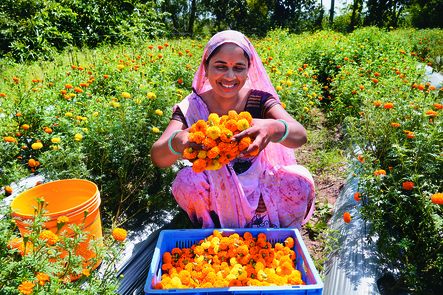
Amidst Limkheda’s blossoms, a farmer gathers marigolds, signifying the success of nurseries and the rise of agro-entrepreneurship

Sumitra Ben and her circle of strength, embody Limkheda’s entrepreneurial leap with NABARD’s aid
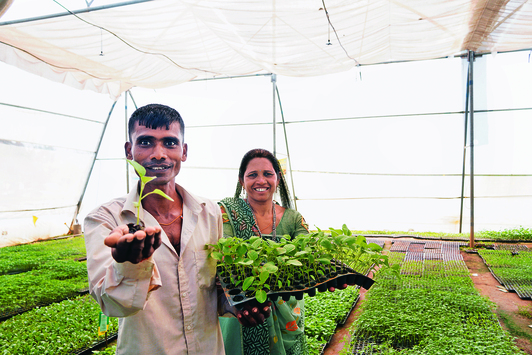
Tech-infused agriculture in Limkheda: A high-tech nursery nurtures 15 lakh seedlings
“ With a current financial commitment of Rs 2,700 crore nationwide, supporting over 950 projects, this programme has significantly impacted over six lakh households.
impacted over six lakh households. Specifically, in Gujarat, 63 projects with nearly Rs 200 crore in funding are active across 13 districts, showcasing NABARD’s dedication to enhancing rural livelihoods.
The Wadi model transcends agricultural innovation; it’s a driver of holistic change, necessitating shifts in mindset, methodology, and expectations. NABARD’s involvement went beyond financial aid; it acted as a mentor and learner, drawing wisdom from tribal communities and promoting holistic development. Exposure trips to successful Wadi sites inspired ambition, laying the groundwork for this transformative initiative.
Sejal, a subject matter expert, underscored NABARD’s unwavering support alongside NM Sadguru Foundation, stating, “Whether addressing leaf infections, optimising irrigation, or formulating market penetration strategies, NABARD’s guidance has remained unwavering.”
Ramesh Patel, with 35 years at PIA, outlined his approach: “We began with a survey, then conducted awareness camps and intensive training sessions, exposing participants to successful models. Groundwork commenced only when they felt confident. Once someone adopts the Wadi model, they never look back.”
This endeavour’s success was not instantaneous, but gradual, beginning with 10 farmers and now aiming to enlist 50, aspiring to break into the Vadodara market.
Seventy-year-old Sumitra Ben, from Limkheda, epitomises the transformative impact of the TDF project. We talk in the warmth of her new shop, which, in itself, is an eloquent symbol of her far-reaching entrepreneurial vision, as are the pick-up truck and a piece of land costing Rs 24 lakh that she bought recently. From the bounties of Mother Earth, her family now reaps an impressive 1.5 lakhs, which, when added to the earnings of her successful grandsons, totals an impressive four lakhs per year. In the past, financial constraints had thwarted her son’s educational prospects. However, now she is filled with pride as her grandsons pursue successful careers, one as a doctor, another as a banker, and the third as a flourishing entrepreneur in the wedding industry
In 2018, farmers initiated a network of high-tech nurseries, transforming the Limkheda block into an agricultural stronghold. These 8-9 nurseries annually produce 15 lakh seedlings, including brinjal, tomato, cauliflower, and marigold, achieving seedling readiness in just 25 days with minimal failures. This network has not only enhanced the community’s agricultural prowess but also funnelled direct profits to the farmers, particularly empowering women in agriculture and spurring economic growth.
Ramesh Patel sees a bigger picture here. “It’s not just about selling produce. We’re equipping our sisters with knowledge. Sustainable, organic farming is the future, and they are at its forefront.”
As the sun sets over these lush Wadis, it’s not the end of the day; it signifies the dawn of a brighter, prosperous future for the tribes of Limkheda. The Wadi symbolises an agricultural renaissance, a beacon of hope, and a sustainable future!
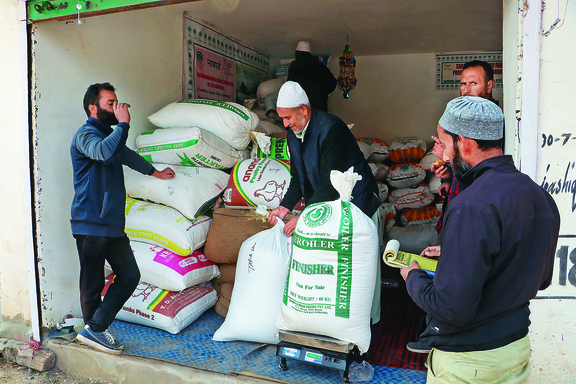
Kashmir’s rice traders in action, reviving the heritage Mushqbudji, known for its unique aroma and high value
Inimitably unique and rare, the fabled Mushqbudji rice is spreading its distinctive fragrance of good fortune across farming communities in Kashmir, backed by a ground-breaking revival plan of NABARD.
When asked about one’s well-being, the standard Kashmiri answer is, “khewan haak bata panun” (eating our greens and rice), which essentially translates into expressing sufficiency, and it is like saying, “I am doing all right.” Distinctively, however, this message of well-being is associated with rice, a staple food in Kashmir, down the ages.
The unique and rare Mushqbudji rice, known for its distinctive fragrance, symbolizes prosperity for Kashmir’s farming communities, thanks to NABARD’s innovative revival plan. This revival underscores the rice’s cultural significance in Kashmir, where expressions of well-being are intertwined with rice consumption. Rice’s cultural significance extends beyond dietary preferences, featuring prominently in local idioms and greetings. Despite its integral role, the prominence of rice, especially the Mushqbudji variety, faced threats from changing agricultural practices, with many fields transitioning to more lucrative crops like apples. Mushqbudji, known for its aroma, vanished due to a fungal disease known as “blast,” which devastated crops in the 1960s, leading to its near extinction.
However, a turning point came 13 years ago when scientists from the Sher-e-Kashmir University of Agricultural Sciences and Technology of Kashmir reintroduced Mushqbudji seeds to farmers like Ghulam Ahmad Naikoo. They promised it would enhance his livelihood and benefit future generations, given its high market value. Naikoo’s initial skepticism turned into a success story, with his Mushqbudji rice fetching Rs 5,000 per quintal in 2013, a trend that continued until 2016.
Despite a drop in government support in 2017, with prices falling to Rs 3500 per quintal from the previous year’s government purchase price of Rs 8400, NABARD’s intervention marked a significant turnaround. Farmers like Mohammad Rafiq Bhat saw a newfound prosperity, dedicating all his land to Mushqbudji cultivation and selling his harvest at Rs 11,000 per quintal to the NABARD’s FPO Sagam Mushqbudji Farmers Producers Company Ltd.
The establishment of the FPO, with initial assistance of Rs 12 lakhs from NABARD, represented a collective effort to streamline Mushqbudji’s production and sales, benefiting from the Geographical Indication (GI) tag that helped gain international attention. Despite challenges, the FPO’s strategic initiatives, led by CEO Zafar Ahmad Bhatt, aim for a significant business turnover, highlighting a sustainable model for rice cultivation and community empowerment in Kashmir.

Farmers walk the fields that nurture Mushqbudji, the rare rice varieties making a comeback
“ The establishment of the FPO, with initial assistance of Rs 12 lakhs from NABARD, represents a collective effort to streamline Kashmir’s popular Mushqbudji rice.
Ghulam Ahmad Naikoo’s transition from struggling with basic sustenance to becoming a prosperous farmer, now investing in livestock and additional land for Mushqbudji cultivation, mirrors the broader impact of NABARD’s program. His contentment, as he reflects on the changes brought by the FPO, symbolizes the revival’s success, blending agricultural innovation with traditional practices for a sustainable future.
NABARD has invested 35 crores in 19 rural infrastructure projects, including roads and bridges, ATMs, primary health centre and more to make Kannur support its tribals
Greenery that can fill your senses. That’s Kerala’s northern hilly district of Wayanad, postcard perfect.
But what lies beyond this beauty is a story of immense struggle through decades for the tribals.
There was a ray of hope when the state government paid Rs 27 crore to the union government for the land, earmarking 3,060 hectares for distribution among landless tribals. About 1,400 tribal families had been allocated land for farming and housing. Challenges arose due to the proximity to a wildlife sanctuary, causing damage to crops by wild animals. The absence of essential facilities hindered the tribals from settling on the allotted lands.
According to C. Sasikumar, Director of the Kasargod-based Centre for Research and Development (CRD), a voluntary organisation that collaborates
with governments, “Many of those who had built houses there felt trapped. Others occupied the land but continued to work as coolies (labourers) elsewhere, rendering the rehabilitation exercise largely meaningless.”
In stepped NABARD with experts, including Sasikumar, who studied the issues and recommended steps for the tribals’ upliftment. After several field visits and discussions among stakeholders and governmental agencies, a Tribal Resettlement Development Mission (TRDM) was initiated in Aralam.
In the five years since its inception, the programme has evolved into a participatory model of affirmative action. Through targeted interventions to enhance the educational and economic standards of the otherwise vulnerable tribal community in Aralam, the TRDM has scored many wins, and the beneficiaries feel things are finally turning in their favour.
Consider the transformation in the life of Sunitha Ramakrishnan, a 39-year-old woman of the Kurichya tribe. Empowered by the guidance, handholding and financial support of NABARD and its affiliates like CRD, she took to goat rearing, beekeeping, and agriculture for her livelihood. The move proved to be a turning point in her life, bringing in a steady stream of income, which is helping her pay for the education of her three children and supplement the income of her husband, who works as a coolie outside the village for better wages. Her three children are studying at ITI, Plus 2, and SSLC levels.
In 2016, the TRDM initiative set out to assist 596 families who willingly joined the program. As the second phase prepares for launch, an additional 500 families, mainly Paniyas along with Kurchias, Karimbalas, and Kattunayakas, will benefit.
Jishimon, the District Development Manager of NABARD in Kannur, explains, “Our project focuses on ensuring the sustainable progress of families through skill development and income-generating opportunities. By offering land testing and expert guidance on crops suitable for their soil, like coconuts, areca nut, pepper, cashew, gooseberry, mango, and papaya, we support the farmers.” NABARD has been the primary source of funding for the project, with a total of Rs 73.5 crore expended across the two phases.
Similarly, a group of women from the Mavilan, Karimbala, and Kurichya tribes has gathered to form a joint liability group that runs a tailoring unit. The unit also caters to bulk orders and supplies ready-made goods to local textile shops.
Janardanan Chami, a 59-year-old member of the Karimbala tribe, is engaged in a NABARD supported project to mitigate human-animal conflicts. This initiative involves installing an electric fence, which Janardanan has worked on for two years, providing him with a stable income.
Furthermore, NABARD has allocated Rs 22 lakh to protect a water spring, benefiting six tribal families. This effort has transformed the spring into a tank, replenishing groundwater and supporting agricultural activities for all involved. Theyan Gopi, 50, a beneficiary, attests to its positive impact. Additionally, six lift irrigation schemes have been implemented, benefiting 400 families, with more initiatives in progress.
NABARD has invested Rs 35 crore in 19 rural infrastructure projects, including roads and bridges. It has also introduced mobile ATMs and enhanced facilities at the local primary health centre. A project aiding farmer-producers to attain better prices for their produce is underway, aiming for comprehensive beneficiary involvement. The region’s proximity to the Aralam Wildlife Sanctuary presents eco-tourism opportunities, with related projects in development.
“ NABARD has allocated Rs 22 lakh to protect a water spring, benefiting 6 tribal families. This effort has transformed the spring into a tank, replenishing groundwater and supporting agricultural activities for all involved.
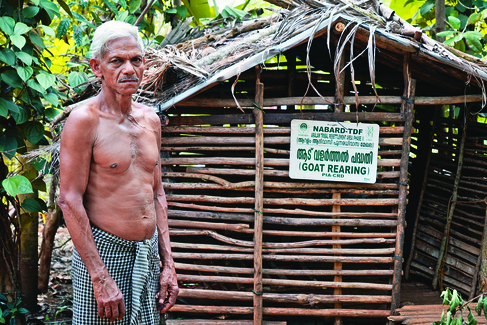
An elder by his goat farm in Wayanad: a testament to new beginnings in traditional livelihoods
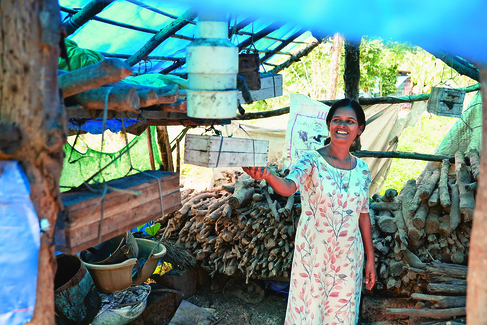
Wayanad’s beehive of activity: a tribal woman’s beekeeping marks the sweet success of skill development
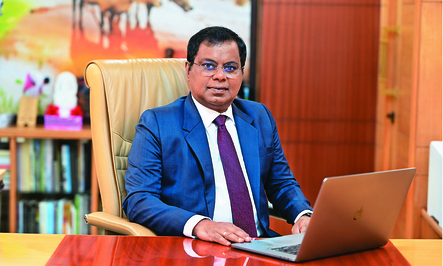
Shaji K V, Chairman, NABARD
“IT IS OUR PRIORITY TO POSITIVELY IMPACT THE REMOTEST CORNERS OF THE COUNTRY”
NABARD’s multifaceted approach to developmental function, touching all aspects of the rural economy, has borne rich rewards. Chairman Shaji K V elaborates on NABARD’s developmental initiatives and outcomes
NABARD’s focus seems quite broad. Can you elaborate on its core areas?
As a premier Development Financial Institution, NABARD’s mission includes securing the all-encompassing prosperity of rural areas through interventions that support rural financial institutions, the development of the rural sector, and the improvement of livelihoods. Our specific focus areas include the institutional development of Cooperative Banks and Regional Rural Banks (RRBs), aimed at augmenting rural infrastructure and development of livelihoods while supervising these institutions to ensure their effective functioning.
Can you give some examples of NABARD’s developmental initiatives?
NABARD acts as a catalyst in various developmental initiatives such as the Self-Help Group Bank Linkage Programme, watershed development programmes, and Tribal development programmes, which empower rural communities. We have also been pioneering the implementation of Farmer Producer Organizations (FPOs), making them digital-ready through platforms like ONDC to connect them directly to consumers, reducing intermediary dependence. Additionally, we support rural business incubation centres and provide venture capital assistance to foster innovative startups in agribusiness and allied sectors.
What are some noteworthy digital initiatives undertaken by NABARD?
We have been instrumental in promoting technology adoption by rural cooperative banks through Core Banking Solutions (CBS). We are facilitating the adoption of additional services like Account Aggregator and UPI for enhanced financial inclusion. We have developed an infrastructure loan processing portal for the State governments. We have also developed e-KCC – a dedicated portal to provide easy credit access to farmers. These portals reduce paperwork and expedite approvals.Furthermore, we are actively involved in creating digital platforms for various purposes. We support interest subvention claim portals for Self Help Groups (SHGs), and also a National Level Comprehensive Portal (NLCP) to capture data about agricultural credit at the block and district levels. This data enables informed decision-making in rural finance.
How does NABARD contribute to sustainability efforts?
NABARD undertakes several sustainability initiatives such as Watershed management, Tribal Development, micro irrigation, and integrated farming, all supported by extensive capacity-building programmes to educate farmers on combating climate challenges and promoting sustainable practices. As a Direct Access Entity (DAE) of the Green Climate Fund (GCF) and the National Implementing Entity (NIE) of the National Adaptation Fund for Climate Change (NAFCC), we are actively involved in funding adaptation and mitigation projects. Moreover, in collaboration with UNDP, we are hosting Data in Climate Resilient Agriculture (DiCRA), a digital platform that provides access to data for optimizing investments in Climate Resilient Agriculture across India’s agriculture ecosystem.




